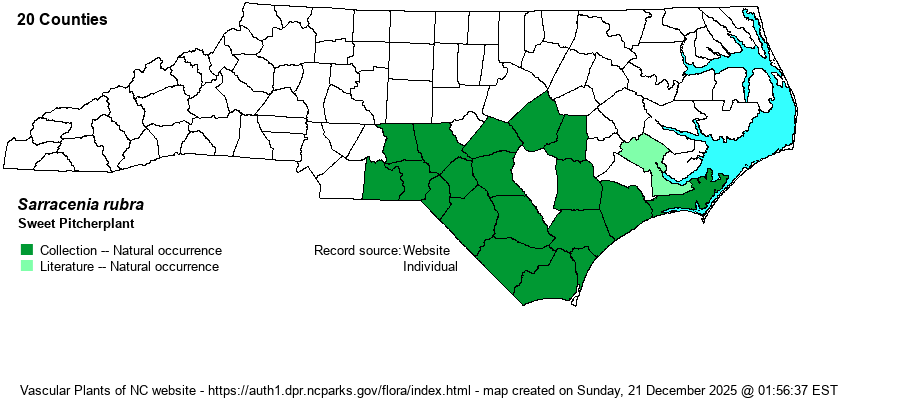| Author | Walter | |
| Distribution | Found throughout the southern half of the Coastal Plain, and barely into the southeastern edge of the Piedmont. Not known north of Craven, Wayne, Johnston, Moore, and Montgomery counties -- the northeastern edge of the range of the species.
This Southeastern species ranges north to southern NC, southwest to the western Panhandle of FL, and west to AL. The species is absent from peninsular FL and most of the lower Coastal Plain of adjacent GA. | |
| Abundance | Uncommon and rather local in the Coastal Plain portion of the range; can be numerous in a few well-managed (by fire) nature preserves, but is quite rare now on private, unprotected lands. Extremely rare in the southeastern edge of the Piedmont. Unlike with other Coastal Plain species in the genus, S. rubra is more widespread in the Sandhills than in the lower Coastal Plain. As with Sarracenia flava and S. purpurea, thankfully it is still numerous enough to stay off the NC NHP Watch List. | |
| Habitat | More frequently found in seepages, such as Sandhill seeps, and pocosin ecotones, than in pine savannas. Thus, it prefers slightly sloping ground where there is some "flowing" water, as a seepage, than on flat ground. In savannas, it is typically found in the wetter spots, such as in swales or scrapes. It can be found in very close proximity to both S. flava and S. purpurea. |
| Phenology | Blooms in the spring, in April and May; fruits in June and July. | |
| Identification | This species has the typical narrow and erect hollow pitchers as seen in S. flava, S. jonesii, and S. oreophila, but it is a noticeably smaller plant. The pitchers, which usually have some red veins and reddish color on the hood, reach only about 1 foot tall, and are often just 6-8 inches tall. The flowering stalk, on a separate stem from the pitchers, generally is taller than the top of the pitchers, up to 1-1.5 feet tall. The single flower is small for the genus, being a deep maroon-purple (as in S. jonesii and S. purpurea), but is barely 1-inch across. The flower nods, and the 5 petals, each about 1-inch long, droop as in other species. This species is noted for its growing in very dense stands, such that a few dozen leaves can often be found in a square foot! Though it can't be confused with other species when in bloom, you will at times see only a few leaves and wonder if they are simply young leaves of S. flava. However, that species has hoods that are generally angled upward and not in a single plane; hoods of S. rubra are rather flat and in a single plane. Because this is such a small pitcherplant, it can easily get overtopped by taller vegetation unless its habitat is burned frequently to cut back on woody species. | |
| Taxonomic Comments | Though this species has always been a valid one, references have divided it up into a handful of subspecies or varieties over the years. One former subspecies was split out as a new species -- S. jonesii, found only in a limited area of southwestern NC and adjacent SC. Weakley (2018) states : "The S. rubra complex consists of five geographically isolated entities, variously treated as species, subspecies, or geographic races". The only current taxon found in NC is the nominate subspecies -- S. rubra ssp. rubra.
| |
| Other Common Name(s) | Weakley (2018) names the nominate subspecies as Carolina Sweet Pitcherplant or Carolina Redflower Pitcherplant. Other names for the full species include Red Pitcherplant and Sweet Trumpet. | |
| State Rank | S3 | |
| Global Rank | G4 | |
| State Status | | |
| US Status | | |
| USACE-agcp | OBL link |
| USACE-emp | OBL link |

